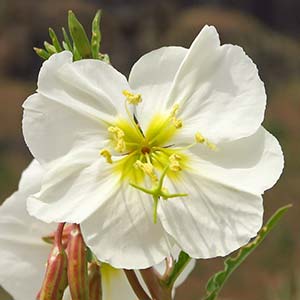Oenothera flava
Oenothera pallida
long-tubed evening primrose, yellow evening primrose
mountain evening primrose, pale evening-primrose, rockweed brush, white-stem evening primrose
(when present) ascending, 1–several, usually densely leafy, 0–2 cm.
erect or ascending, single to several from base, unbranched or many-branched throughout, 10–50(–70) cm.
primarily in a basal rosette, (3.4–)6–30(–36) × (0.5–)1.5–5(–7) cm, flexible, sometimes ± fleshy;
petiole (0.2–)2–7(–10) cm;
blade oblanceolate to linear, margins usually irregularly and coarsely pinnately lobed, rarely subentire, apex acute.
cauline, rosette usually weakly developed or absent, at least during flowering, sometimes well developed, 1–5(–7.8) × 0.3–1(–1.5) cm;
petiole 0–2(–4.5) cm;
blade lanceolate, oblong, linear-lanceolate, or ovate, margins subentire or remotely denticulate, deeply sinuate-dentate, or pinnatifid, sometimes repand.
1–4 opening per day near sunset;
buds with free tips (1–)2–10(–12) mm;
floral tube (24–)40–200(–265) mm;
sepals (8–)11–40(–42) mm;
petals bright yellow, sometimes paler (in smaller-flowered plants), fading pale orange, drying purple, (7–)10–45(–50) mm;
filaments (5–)8–23(–26) mm, anthers (2–)3–13(–16) mm;
style (40–)50–250(–290) mm, stigma exserted beyond or surrounded by ring of anthers.
1–several opening per day near sunset;
buds nodding, weakly quadrangular, with free tips 0–2 mm;
floral tube 15–40 mm;
sepals 10–30 mm, not spotted;
petals white, fading pink to deep pink, broadly obovate or obcordate, (10–)15–25(–40) mm;
filaments 9–15 mm, anthers 3–10 mm;
style 25–55 mm, stigma exserted beyond anthers at anthesis.
leathery in age, surface usually conspicuously reticulate, usually narrowly ovoid or ellipsoid, sometimes ovoid or lanceoloid, winged, wings narrowly oblong, (2–)3–5(–6) mm wide, confined to distal 2/3 of capsule, (10–)20–35(–43) × 4–8 mm (excluding wings), gradually constricted to a short beak, dehiscent 1/4–1/2 their length, valve surface usually conspicuously reticulate;
sessile.
spreading to reflexed, straight to curved or contorted, cylindrical, obtusely 4-angled, tapering slightly from base to apex, 15–60 × 1.5–2.5 mm;
sessile.
asymmetrically cuneiform, 1.8–2.2(–2.6) mm.2n = 14.
numerous, in 1 row per locule, brownish with dark spots or black, narrowly obovoid, 1.5–2.2 mm.
Oenothera flava
Oenothera pallida
Petals in Oenothera flava typically range from 7–32 mm with floral tubes 24–100 mm; however, plants from three disjunct areas: the Mogollon Plateau in Arizona to Catron County, New Mexico; Sacramento Mountains and Sierra Blanca, Lincoln and Otero counties, New Mexico; and the Sierra Madre Occidental from northern Chihuahua south to Durango, have much larger petals (30–55 mm) and longer floral tubes (80–265 mm). They were originally recognized as a distinct species or most recently as a subspecies (O. flava subsp. taraxacoides), but detailed study of the variation pattern suggests that the larger flowers occur in areas of high hawkmoth species diversity and higher rates of outcrossing, similar to the pattern discussed in detail by D. P. Gregory (1963, 1964). R. A. Raguso et al. (2007) and H. E. Summers et al. (2015) came to the same conclusion in an independent study of floral biology of sect. Lavauxia. Because populations from the three disjunct areas appear to have diverged independently from lower-elevation source populations, it seems best to treat the complex as one variable species without any formal subdivision.
(Discussion copyrighted by Flora of North America; reprinted with permission.)
Subspecies 4 (4 in the flora).
Oenothera pallida is a poorly understood species currently subdivided into four subspecies (W. L. Wagner et al. 2007) that differ largely in aspect, leaf division, capsule configuration, and pubescence. The variation pattern is rather complex with almost no diagnostic character uniformly distinguishing any one of the subspecies. Instead, each of the subspecies, which are mostly geographically separated although there is some level of overlap, have diagnostic suites of characters that maintain their linkage some of the time, but break down across the geographic area of each so that no single character uniquely identifies it. Each subspecies is characterized by leaf, pubescence, and, often, habit features. The issues with the integrity and intergradations of the subspecies are discussed below.
Oenothera pallida has been determined to be self-incompatible (W. L. Wagner et al. 2007), but K. E. Theiss et al. (2010) determined that although most populations of subsp. pallida are self-incompatible, one near Salt Lake City is self-compatible.
(Discussion copyrighted by Flora of North America; reprinted with permission.)
1. Herbs annual, sometimes perennial from a taproot, when perennial, sometimes with lateral roots producing adventitious shoots, strigillose throughout and villous distally, especially on flower parts. | subsp. trichocalyx |
1. Herbs perennial from a taproot and with lateral roots producing adventitious shoots, glabrous, strigillose, or sparsely villous. | → 2 |
2. Plants glabrous, sometimes strigillose, rarely sparsely villous; leaf blade margins usually subentire or remotely denticulate, rarely pinnatifid; capsules usually contorted to curved. | subsp. pallida |
2. Plants usually strigillose, rarely villous or glabrous; leaf blade margins shallowly sinuate-dentate or denticulate, or deeply sinuate-dentate to pinnatifid, rarely only dentate; capsules usually straight or curved, sometimes contorted. | → 3 |
3. Leaf blades (0.4–)0.7–1.5 cm wide, margins shallowly sinuate-dentate or denticulate. | subsp. latifolia |
3. Leaf blades 0.4–1(–1.5) cm wide, margins usually deeply sinuate-dentate to pinnatifid, rarely dentate only. | subsp. runcinata |
- Local floras:
CA,
OR,
WA
- Local Web sites:
CalFlora,
CalPhotos,
Flora NW,
PNW Herbaria
WildflowerSearch
iNaturalist (observations)
USDA Plants Database
- LBJ Wildflower Center
- SEINet
- Plants of the World Online
- Encyclopedia of Life
- Wikipedia
- Google Image Search
